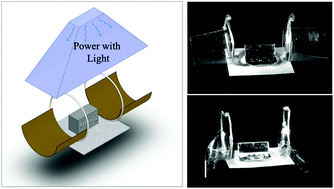Torque-dense photomechanical actuation†
Abstract
Contactless actuation powered using light is shown to generate torque densities approaching 10 N m kg−1 at angular velocities ∼102 rad s−1: metrics that compare favorably against tethered electromechanical systems. This is possible even though the extinction of actinic light limits the characteristic thickness of photoresponse in polymers to tens of μm. Confinement of molecularly patterned developable shells fabricated from azobenzene-functionalized liquid crystalline polymers encodes torque-dense photoactuation. Photostrain gradients from unstructured irradiation segment this geometry into two oppositely curved regions connected by a curved crease. A monolithic curved shell spontaneously bifurcates into a jointed, arm-like mechanism that generates flexure over sweep angles exceeding a radian. Strain focusing at the crease is hierarchical: an integral crease nucleates at smaller magnitudes of the prebiased curvature, while a crease decorated with point-like defects emerges at larger curvatures. The phase-space of morphogenesis is traceable to the competition between stretch and bending energies and is parameterizable as a function of the geometry. The framework for generating repetitive torque-dense actuation from slender light-powered actuators holds broader implications for the design of soft, remotely operated machines. Here, it is harnessed in illustrative mechanisms including levers, lifters and grabbers that are powered and regulated exclusively using light.



 Please wait while we load your content...
Please wait while we load your content...
